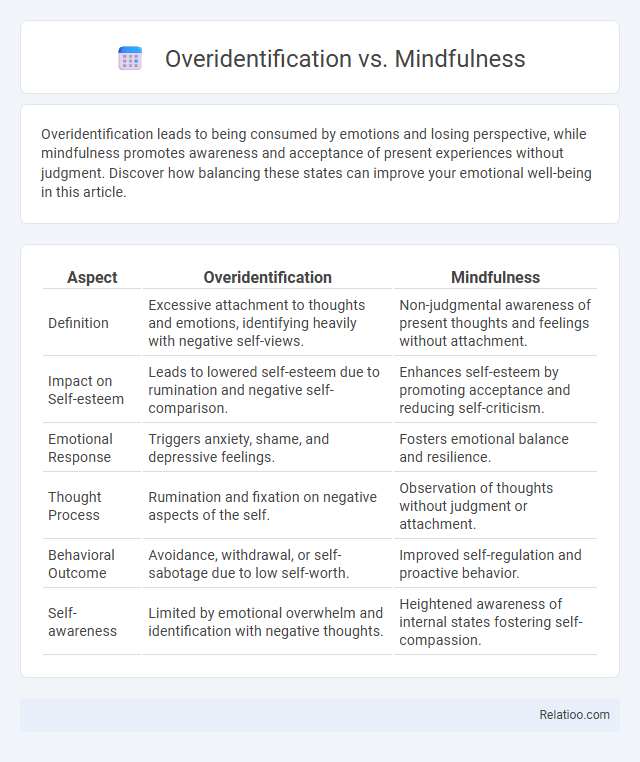Overidentification leads to being consumed by emotions and losing perspective, while mindfulness promotes awareness and acceptance of present experiences without judgment. Discover how balancing these states can improve your emotional well-being in this article.
Table of Comparison
| Aspect | Overidentification | Mindfulness |
|---|---|---|
| Definition | Excessive attachment to thoughts and emotions, identifying heavily with negative self-views. | Non-judgmental awareness of present thoughts and feelings without attachment. |
| Impact on Self-esteem | Leads to lowered self-esteem due to rumination and negative self-comparison. | Enhances self-esteem by promoting acceptance and reducing self-criticism. |
| Emotional Response | Triggers anxiety, shame, and depressive feelings. | Fosters emotional balance and resilience. |
| Thought Process | Rumination and fixation on negative aspects of the self. | Observation of thoughts without judgment or attachment. |
| Behavioral Outcome | Avoidance, withdrawal, or self-sabotage due to low self-worth. | Improved self-regulation and proactive behavior. |
| Self-awareness | Limited by emotional overwhelm and identification with negative thoughts. | Heightened awareness of internal states fostering self-compassion. |
Understanding Overidentification: Definition and Signs
Overidentification occurs when you become deeply entangled with your thoughts and emotions, losing perspective and experiencing heightened distress. Mindfulness, in contrast, emphasizes non-judgmental awareness of the present moment, allowing you to observe thoughts without becoming overwhelmed. Recognizing signs of overidentification includes feeling consumed by negative self-talk, ruminating excessively, and reacting emotionally as if your thoughts define your reality.
What is Mindfulness? Core Principles Explained
Mindfulness is the practice of maintaining a non-judgmental awareness of your present moment experiences, thoughts, and emotions, distinct from overidentification where you overly attach to these experiences. Core principles include paying attention intentionally, accepting your experiences without resistance, and cultivating a curious, open attitude towards yourself and the world. Practicing mindfulness helps you observe your thoughts without getting lost in them, fostering emotional regulation and mental clarity.
Overidentification vs Mindfulness: Key Differences
Overidentification occurs when your thoughts and emotions become overwhelmingly entangled, causing you to lose perspective and amplify distress. Mindfulness contrasts this by encouraging present-moment awareness without judgment, allowing you to observe experiences without being consumed by them. Understanding these key differences helps you regulate emotional responses more effectively, promoting mental clarity and resilience.
Psychological Impacts of Overidentification
Overidentification involves becoming excessively attached to thoughts and emotions, often resulting in heightened stress, anxiety, and reduced emotional regulation. In contrast, mindfulness cultivates a non-judgmental awareness of present experiences, promoting psychological resilience and improved mental well-being. The psychological impacts of overidentification include increased vulnerability to negative mood states and difficulty detaching from distressing mental content, which mindfulness practices can effectively mitigate.
How Mindfulness Counters Overidentification
Mindfulness counteracts overidentification by fostering present-moment awareness and non-judgmental observation of thoughts and emotions, preventing you from becoming entangled in negative self-concepts. By practicing mindfulness, your brain strengthens neural pathways associated with emotional regulation and cognitive flexibility, reducing the intensity and frequency of ruminative thought patterns linked to overidentification. This shift promotes a healthier self-perception, where thoughts are seen as transient mental events rather than defining truths.
Common Triggers of Overidentification
Common triggers of overidentification include negative self-talk, emotional distress, and unprocessed past experiences that cause You to merge your identity with these thoughts and feelings. Unlike mindfulness, which promotes observation without judgment, overidentification intensifies emotional reactions and limits your ability to detach from distressing mental patterns. Recognizing these triggers is crucial for developing healthier coping mechanisms and enhancing emotional regulation.
Benefits of Embracing Mindfulness Practices
Embracing mindfulness practices enhances emotional regulation by helping you observe your thoughts without overidentifying with them, leading to reduced stress and increased mental clarity. Mindfulness fosters greater self-awareness and compassion, contrasting with overidentification that often amplifies negative emotions and rumination. Cultivating this skill supports well-being, resilience, and improved focus in daily life.
Practical Strategies to Shift from Overidentification to Mindfulness
Overidentification occurs when you become excessively attached to negative emotions, causing them to dominate your thoughts and behavior, whereas mindfulness encourages observing these feelings without judgment or attachment. Practical strategies to shift from overidentification to mindfulness include practicing focused breathing exercises, engaging in body scan meditations, and using grounding techniques to reconnect with the present moment. Incorporating daily mindfulness practices helps you develop greater emotional awareness and reduces the intensity of overidentified thoughts, promoting mental clarity and emotional balance.
Real-Life Examples: Overidentification and Mindfulness in Action
Overidentification occurs when individuals become excessively attached to their thoughts and emotions, such as a person constantly ruminating on a mistake at work, leading to increased stress and anxiety. In contrast, mindfulness encourages observing these thoughts without judgment, like acknowledging frustration during a traffic jam without letting it escalate into anger. Real-life examples demonstrate mindfulness helping individuals manage emotions effectively, while overidentification often exacerbates negative mental states and hinders emotional regulation.
Conclusion: Choosing Mindfulness for Emotional Wellbeing
Choosing mindfulness enhances emotional wellbeing by fostering present-moment awareness and reducing automatic identification with negative thoughts, unlike overidentification which intensifies emotional distress. Mindfulness promotes balanced cognitive processing and resilience by encouraging observation without judgment, helping individuals break free from harmful rumination patterns common in overidentification. Prioritizing mindfulness techniques such as breath awareness and body scans leads to improved emotional regulation and psychological health, distinguishing it as a superior practice for managing emotional challenges.

Infographic: Overidentification vs Mindfulness
 relatioo.com
relatioo.com